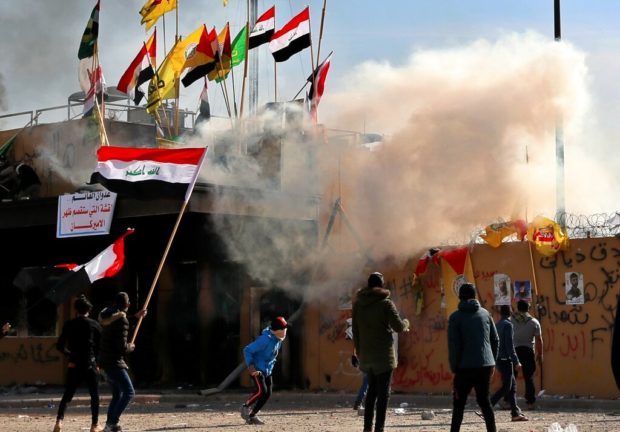US troops fire tear gas at pro-Iran protesters in Iraq

Pro-Iranian militiamen and their supporters set a fire while U.S. soldiers fired tear gas during a sit-in in front of the U.S. embassy in Baghdad, Iraq, Wednesday, Jan. 1, 2020. U.S. troops fired tear gas on Wednesday to disperse pro-Iran protesters who were gathered outside the U.S. Embassy compound in Baghdad for a second day as dozens of pro-Iranian militiamen and their supporters had camped out at the gates of the embassy in Baghdad, where they stayed the night. On Tuesday, dozens of the protesters had broken into the compound, trashing a reception area and smashing windows in one of the worst attacks on the embassy in recent memory. (AP Photo/Khalid Mohammed)
BAGHDAD — U.S. troops fired tear gas on Wednesday as hundreds of Iran-backed militiamen and other protesters gathered outside the American Embassy in Baghdad for a second day and set fire to the roof of a reception area inside the compound.
Dozens of Iran-allied militiamen and their supporters had camped out at the gates of the embassy overnight, a day after they broke into the compound, trashing a reception area, smashing windows and spraying graffiti before pulling back. It was one of the worst attacks on a U.S. diplomatic mission in years.
The U.S. Marines guarding the embassy fired tear gas Wednesday as more crowds arrived and after the protesters lit a fire on the roof of the reception area. Smoke rose from the building. There have been no reports of any injuries since the protests began.
Later, Iraqi soldiers, federal police and elite counterterrorism forces deployed along the fence between the protesters and the compound. There was no friction between the security forces and the demonstrators.
The militiamen were protesting deadly U.S. airstrikes that targeted an Iran-backed militia on Sunday, killing 25 fighters. Those strikes were in response to a rocket attack on an Iraqi army base that killed a U.S. contractor last week.
Article continues after this advertisementThe violence comes as Iran and its allies across the region have faced unprecedented mass protests in recent months and after heavy U.S. sanctions on Iran that have cratered its economy.
Article continues after this advertisementIraq has seen massive anti-government protests since October fueled by anger at widespread corruption and economic mismanagement, as well as Iran’s heavy influence over the country’s affairs. Those protesters were not involved in the embassy attack.
President Donald Trump blamed Iran for the attack on the embassy and Defense Secretary Mark Esper later announced the immediate deployment of an infantry battalion of about 750 soldiers from the Army’s 82nd Airborne Division to the Middle East. He did not specify their destination, but a U.S. official familiar with the decision said they will go to Kuwait.
Iran has denied any involvement in the attack on the embassy. Foreign Ministry spokesman Abbas Mousavi was quoted by state media on Tuesday as warning the U.S. against any “miscalculation” in the worsening standoff.
In an apparent reference to Trump’s allegations of Iranian involvement, Iran’s supreme leader, Ayatollah Ali Khamenei, was quoted by semi-official media as saying that “if the Islamic Republic makes a decision to confront any country, it will do it directly.”
Iran later summoned the Swiss charge d’affaires, who represents American interests in Tehran, to protest what it said was war-mongering by U.S. officials, the state-run IRNA news agency reported.
The U.S. and Iran have vied for influence over Iraq since the 2003 U.S.-led invasion that toppled Saddam Hussein. Iran has close ties to Iraq’s Shiite majority and many of its major political factions, and its influence has steadily grown since then.
Iran helped to mobilize tens of thousands of mostly Shiite militiamen to battle the Islamic State group when it stormed across northern and western Iraq in 2014 as the armed forces collapsed. In the subsequent campaign against the extremists, the U.S. and Iran both provided vital aid to Iraqi forces, who eventually declared victory in December 2017.
The political influence of the Iran-backed militias, known as the Popular Mobilization Forces, has risen in recent years, and their allies dominate the parliament and the government. That has made them the target of the anti-government protests.
The anti-government protesters have attacked Iranian diplomatic missions and the local headquarters of parties affiliated with the militias across southern Iraq. They have also set up a major protest camp in central Baghdad.
For weeks, the anti-government protesters have been trying to enter the Green Zone housing the government and the U.S. Embassy, but have been beaten back by security forces, who have killed hundreds of demonstrators.
The militiamen and their supporters, however, were able to quickly enter the Green Zone and mass in front of the embassy, with little if any resistance from authorities.
By Wednesday morning, they had set up a small sit-in of their own, with around 50 tents set up between two main gates about 500 meters (yards) apart. Demonstrators set up a makeshift clinic and cooks with aprons reading “Popular Mobilization Forces logistical support” served meals out of giant pots. Mobile toilets were also set up in the area.
Vehicles belonging to the Popular Mobilization Forces, with government plates, were parked nearby, and the militiamen manned checkpoints where they searched all those arriving at the site of the demonstration.
Outside one of the gates, a Shiite cleric recited verses from the Muslim holy book, the Quran, through a loudspeaker. Another cleric led the protesters in midday prayers.
Demonstrators could be seen hurling rocks over the walls of the embassy compound, where U.S. troops responded by firing tear gas from the roofs of buildings. At one point, two armed security guards mounted a structure inside the embassy near the gate and the demonstrators began throwing stones toward them, forcing them to withdraw.